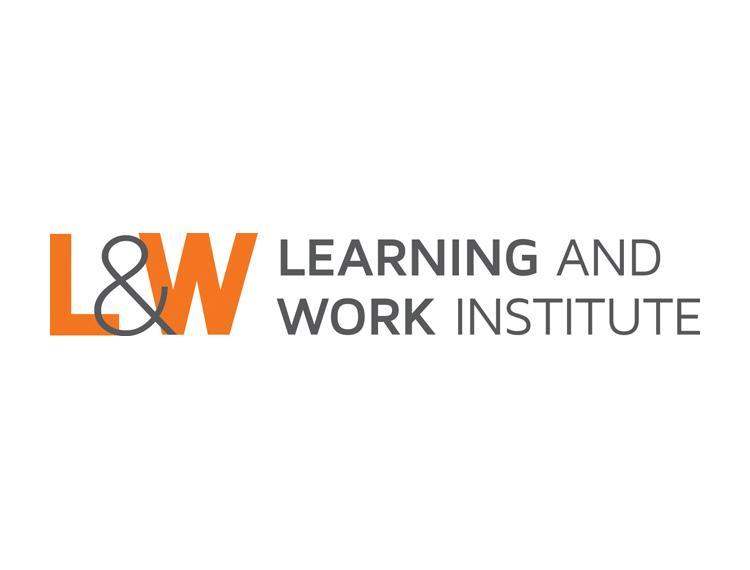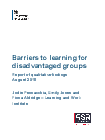Barriers to learning for disadvantaged adults

Learning has positive benefits for individuals, communities and the wider economy.
Increasing and widening access to learning is crucial to future prosperity, fairness and social inclusion in the UK. Despite the strength of this evidence, the UK has seen a recent decline in the number of adults participating in learning and training.
To address this challenge the Government is developing a National Retraining Scheme to ensure the UK remains competitive in a global economy and to improve social mobility. If we are to engage more adults in learning, it is vital that we understand patterns of behaviour and adults’ motivations and the barriers to their engagement. Learning and Work Institute (L&W) is an independent policy and research organisation dedicated to promoting lifelong learning, full employment and inclusion.
For over 20 years, L&W (previously NIACE) has undertaken an annual survey of adult participation in learning. The survey, which draws on data from a national representative survey of 5,000 adults across the UK (or Great Britain in 2017), provides a rich evidence base on who participates in learning, their motivations, and any barriers and benefits experienced. The 2017 survey and this qualitative study were funded by the Department for Education (DfE).
In 2017, for the first time, in-depth qualitative interviews have been undertaken with a sample of survey respondents, including those who are currently, or have recent experience of, learning and adults who have not participated in learning for at least three years.
These interviews explored the barriers to learning, motivations to learn, events or circumstances that triggered learning, facilitators that support access to learning, and potential levers to engaging other adults in learning. Interviews were sought with people with demographic characteristics typically associated with lower participation to provide insights on how policy and practice interventions can best target groups who are currently underrepresented in learning provision.
This report presents the findings from the interviews, including illustrative case studies of individual’s experiences, and sets out considerations for policy aimed at engaging more and different adults in learning.
Key Findings
- Motivations for learning amongst adults are wide-ranging and influenced by personal, social and economic circumstances, as well as past experiences. Extrinsic motivations for learning, particularly in relation to job progression, were discussed. Intrinsic motivations were particularly strong across accounts, and were connected with health and wellbeing, confidence, and the enjoyment of learning.
- Adults face a range of situational, institutional and dispositional barriers as they navigate learning opportunities. Whilst all participants were able to discuss at least one barrier they faced to taking up learning, the most disadvantaged learners were more likely to describe the cumulative effect of multiple barriers to learning. These groups included: people in receipt of benefits; people with disabilities and health conditions; single parents; and participants whose first language is not English.
- A set of practical and circumstantial factors often need to be in place to facilitate learning. These are connected with overcoming some of the barriers to learning, such as cost, childcare, awareness of opportunities and employer support.
- Being motivated to learn, and learning being made easy or easier, is not always sufficient for learning to happen. Participant portraits show that learning is often triggered at the intersection between larger shifts – life changing and traumatic events such as a bereavement – and smaller, pragmatic, situational experiences such as the discovery of an affordable course. ‘Trigger’ refers to the tipping of the balance where motivations for learning outweigh any barriers that are faced. Learning is triggered at the point in time when it becomes apparent, sufficiently accessible and worth it.
- Participants suggested a range of avenues for supporting more adults to learn. These included overcoming practical barriers such as cost and childcare, and strongly and inclusively conveying the value of learning. Participants advocated awareness raising campaigns which highlight that learning is for everyone. They also advocated making information available on the internet but also in public forums so that people encounter it as they go about their everyday life.
Considerations for policy and practice
- The barriers to learning experienced by adults are multi-layered and interrelated. Interventions seeking to engage adults in learning should therefore seek to address more than one type of barrier.
- Dispositional barriers, such as a fear of learning or low levels of confidence, can prevent adults from taking steps towards learning. While this is very personal, learning provision should be designed to build confidence, for example through bite-sized courses or discrete units, which can be extended as learners’ progress.
- Adults are motivated to learn if the potential outcomes are clear and valued. Evidence on the positive outcomes and potential impact of learning as an adult should therefore be widely communicated. This could include high-profile awareness raising campaigns and/or better availability of information about the potential returns on learning.
- The perceived benefits of learning are complex, indirect and wide-ranging including improved health, well-being and social relationships, in addition to work and career progression. It is important that outreach and engagement with adults taps into different motivations they may have, which can change throughout the life-course.
- Learning as an adult is predominantly a voluntary activity. Opportunities need to be visible and accessible, and accompanied by good quality information. Information about learning opportunities should be shared and communicated proactively in a variety of ways, including the internet and in public spaces so that people come across them in everyday life.
- Many adults experience competing priorities such as work, family and caring responsibilities. Learning provision therefore needs to accommodate this and offer flexibility, for example outside of working hours, online and/or blended learning.
Qualitative research exploring the barriers, motivations and triggers for learning among adults.

Barriers to learning for disadvantaged groups
Ref: ISBN 978-1-78105-909-8, DFE-RR819PDF, 589KB, 53 pages
Details
This qualitative study delivers insight into the range of barriers to learning that adults face, as well as their motivations and triggers for learning.
It also presents adults’ recommendations on how to encourage others to take up learning.
It’s based on in-depth interviews with both learners and non-learners.
Detailed findings from a survey of over 5,000 adults who participate in learning has also been published.











Responses